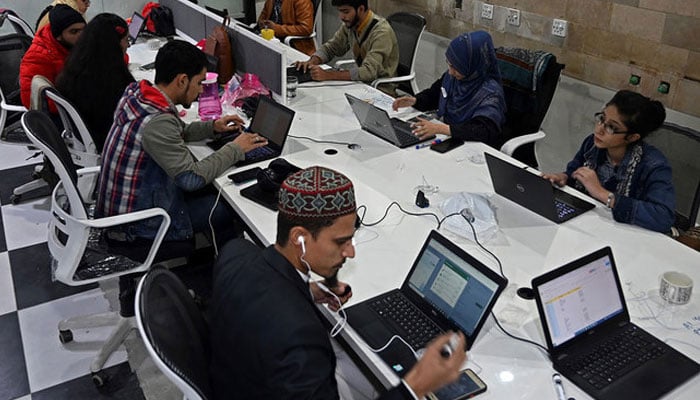Tech parks for growth
These designated areas are often referred to as research and technology parks or science parks
In today’s fast-paced global economy, technology parks play a crucial role in fostering industrial development by providing an ecosystem conducive to innovation, collaboration and entrepreneurship.
These designated areas are often referred to as research and technology parks or science parks. They can serve as catalysts for economic growth, driving technological advancements, attracting investment, and nurturing talent. By bringing together academia, industry, and government, these parks facilitate collaboration and knowledge exchange, leading to breakthrough discoveries and technological advancements.
They are often located within or near universities so that they have ready access to highly trained workers in various fields. In Pakistan, I was involved in establishing a technology park in the National University of Science and Technology in Islamabad as well as setting up several software technology parks in early 2001 in Islamabad, Lahore, Karachi and Peshawar. More recently, an excellent technology park was established under my supervision within the Pak-Austria Fachhochschule (University of Applied Science and Engineering) in Haripur, Hazara.
Technology parks play a crucial role in enhancing the competitiveness of industries by providing access to state-of-the-art infrastructure, specialized facilities, and cutting-edge equipment. Companies located within technology parks benefit from shared resources such as research laboratories, testing facilities, and prototyping centres, enabling them to accelerate the development and commercialization of new products.
Moreover, the clustering effect of technology parks encourages the formation of industry clusters, where companies operating in related sectors can collaborate, share best practices, and access a pool of skilled talent.
Silicon Valley, located in San Francisco, is arguably the most famous technology park globally and a symbol of innovation and entrepreneurship. Home to numerous tech giants such as Apple, Google, and Facebook, Silicon Valley has a rich history of fostering disruptive innovations that have transformed entire industries. The ecosystem of Silicon Valley is characterized by a dense concentration of venture capital firms, leading research universities such as Stanford and UC Berkeley, and a culture that celebrates risk-taking and failure as essential ingredients for success.
Through collaboration, knowledge sharing, and access to capital, Silicon Valley has become synonymous with technological breakthroughs in computing, software development, biotechnology and beyond.
The Zhongguancun Science Park, often dubbed China’s Silicon Valley, is another thriving technology hub located in Beijing’s Haidian District. Established in the 1980s, Zhongguancun has grown into a dynamic ecosystem of innovation, fuelled by a convergence of research institutions, universities, and high-tech companies.
The park is home to leading Chinese tech firms such as Baidu, Lenovo, and Xiaomi, as well as numerous startups and venture capital firms. Zhongguancun’s strategic focus on emerging technologies such as artificial intelligence, semiconductors, and biotechnology has propelled China’s technological advancement and global competitiveness.
Another excellent example is Technopark, situated in Thiruvananthapuram, Kerala. It is one of India’s largest and most successful technology parks, specializing in software development and IT-enabled services. Established in the 1990s, Technopark has played a crucial role in positioning Kerala as a leading destination for IT outsourcing and technology innovation. The park’s ecosystem encompasses a diverse range of companies, from multinational corporations to startups, as well as research and development centres and education institutions.
The Hsinchu Science Park, located in northern Taiwan, is a leading technology park renowned for its semiconductor industry and innovation ecosystem. Established in the 1980s, the Hsinchu Science Park has played a pivotal role in Taiwan’s economic development, driving advancements in semiconductor manufacturing, integrated circuit design, and electronics. The park is home to major semiconductor companies such as TSMC, MediaTek, and United Microelectronics Corporation (UMC), as well as research institutes and startups.
Hsinchu’s collaborative environment, supported by government investment in infrastructure, research, and talent development, has fostered a culture of innovation and entrepreneurship, propelling Taiwan to become a global leader in semiconductor technology and high-tech manufacturing.
Cyberjaya, situated in the state of Selangor, Malaysia, is the country’s premier technology park and a key driver of its digital economy and innovation ecosystem. Established in the late 1990s, Cyberjaya has evolved into a dynamic hub for technology companies, research institutions, and startups, specializing in areas such as information technology, telecommunications, and digital services.
The park’s strategic location, supported by world-class infrastructure and government incentives, has attracted leading multinational corporations such as IBM, Huawei, and DHL, as well as homegrown startups and technology firms. Cyberjaya’s collaborative environment, facilitated by initiatives such as the Cyberjaya Innovation Hub and the Malaysian Global Innovation and Creativity Centre (MaGIC), has fostered entrepreneurship, talent development, and technological innovation, driving Malaysia’s digital transformation and economic growth.
The Pardis Technology Park, located in Tehran, Iran, is the country’s premier technology park and a key driver of its innovation ecosystem. Established in the early 2000s, Pardis serves as a hub for technology companies, startups, and research institutions, specializing in sectors such as ICT, nanotechnology, and renewable energy. The park’s strategic location, supported by government incentives and infrastructure investment, has attracted leading Iranian and international companies, fostering collaboration, technology transfer, and entrepreneurship.
Cambridge Science Park, located in the historic city of Cambridge, is one of the world’s oldest and most prestigious technology parks. Founded in the 1970s, the park has been instrumental in driving innovation and entrepreneurship in the UK, particularly in the fields of life sciences, biotechnology, and advanced manufacturing.
Home to renowned institutions such as the University of Cambridge and the Wellcome Sanger Institute, Cambridge Science Park provides a fertile ground for collaboration between academia and industry. The park’s ecosystem of startups, research organizations, and multinational corporations has led to groundbreaking discoveries and technological advancements, including the development of the first genetically engineered drug, Humira.
Sophia Antipolis, situated in the scenic French Riviera, is Europe’s largest science and technology park, renowned for its picturesque setting and innovative ecosystem. Established in the 1960s, Sophia Antipolis has evolved into a vibrant hub for technology companies, research institutes, and startups, spanning sectors such as telecommunications, biotechnology, and sustainable development.
It is apparent that technology parks play a crucial role in fostering innovation, driving economic growth, and shaping the future of industries. Through their collaborative ecosystems, supportive infrastructure, and access to talent, these designated areas serve as catalysts for technological advancements, entrepreneurship, and job creation.
The Ministry of IT and Telecommunications, Ministry of Science and Technology, Ministry of Industries and the Higher Education Commission will be well advised to join hands with relevant provincial ministries to establish such parks with liberal venture capital funds within all major universities in Pakistan to foster innovation and entrepreneurship and promote industrial development in new and emerging fields.
The writer is a former federal minister, Unesco
science laureate and founding chairperson of the Higher
Education Commission (HEC). He can be reached at: ibne_sina@hotmail.com
-
 Sarah Ferguson Considers Unique Surgical Approach To Seeking Forgiveness For Epstein Fiasco
Sarah Ferguson Considers Unique Surgical Approach To Seeking Forgiveness For Epstein Fiasco -
 Prince Harry, Meghan Markle Face Fresh Scrutiny Over Christmas Family Photo
Prince Harry, Meghan Markle Face Fresh Scrutiny Over Christmas Family Photo -
 Watch: Kate Middleton Promises An Extra Special Something For Together At Christmas
Watch: Kate Middleton Promises An Extra Special Something For Together At Christmas -
 Kim Kardashian Goes Incognito On Holiday Ski Trip, Fans Can’t Recognize Her
Kim Kardashian Goes Incognito On Holiday Ski Trip, Fans Can’t Recognize Her -
 King Charles Gives A History Lesson To Royal Fans Ahead Of Christmas Broadcast
King Charles Gives A History Lesson To Royal Fans Ahead Of Christmas Broadcast -
 How King Charles Is Reacting To Abdication Rumours, Prince William's Succession Talks?
How King Charles Is Reacting To Abdication Rumours, Prince William's Succession Talks? -
 Space Race Intensifies As Russia Plans Lunar Nuclear Power Plant By 2036
Space Race Intensifies As Russia Plans Lunar Nuclear Power Plant By 2036 -
 Italy Orders Meta To Suspend WhatsApp Terms Prohibiting Rival AI Chatbots
Italy Orders Meta To Suspend WhatsApp Terms Prohibiting Rival AI Chatbots -
 Serena Williams Surprises Sister With Most Expensive Wedding Gift
Serena Williams Surprises Sister With Most Expensive Wedding Gift -
 Kris Jenner Names Kardashian-Jenner Who Is The ‘hardest’ To Get Gifts For
Kris Jenner Names Kardashian-Jenner Who Is The ‘hardest’ To Get Gifts For -
 Should Meghan Markle, Prince Harry Return To The UK For Christmas? Royal Fans Give Verdict
Should Meghan Markle, Prince Harry Return To The UK For Christmas? Royal Fans Give Verdict -
 Prince Harry, Meghan Markle Emotional Moment With Injured Dog Revealed
Prince Harry, Meghan Markle Emotional Moment With Injured Dog Revealed -
 Scientist Find New Clue To Spot Mental Health Risk
Scientist Find New Clue To Spot Mental Health Risk -
 UFO Expert Makes Startling Revelation About Interaction With Aliens
UFO Expert Makes Startling Revelation About Interaction With Aliens -
 Prince Harry 'determined' To Secure Stable Future For Archie, Lilibet Away From Crown
Prince Harry 'determined' To Secure Stable Future For Archie, Lilibet Away From Crown -
 Trump Flew On Epstein Jet Eight Times In 90s, Prosecutor Email Claims
Trump Flew On Epstein Jet Eight Times In 90s, Prosecutor Email Claims




